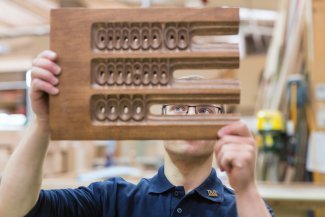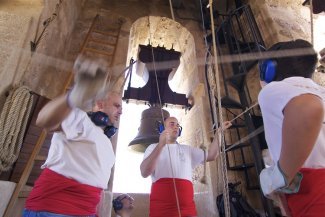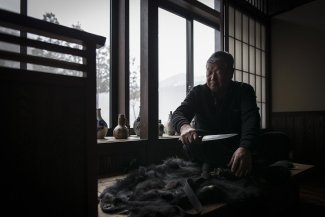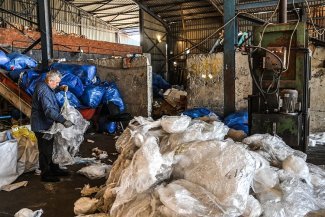
Katsuji Okada has spent a lifetime laying millions of kawara tiles. We spoke with him to learn about the details of this ancestral craft, part of an indigenous architecture that is now on the verge of extinction.
Traditional Japanese roofs, typified by kawara tiles, have covered temples and homes in the archipelago for centuries. Valued for generations for their exceptional resistance to the elements as well as the elegance of their winged shapes and metallic colour, today they are increasingly becoming a relic of the past.
Japan’s architectural landscape has transformed rapidly as new materials and techniques have been introduced. In both urban and rural areas, Japanese families increasingly live in modern buildings. Traditional Japanese home aesthetics are disappearing, and with them, the trades that were once handed down from father to son. Katsuji Okada has spent a lifetime laying millions of kawara tiles. We spoke with him to learn about the details of this ancestral craft, part of an indigenous architecture that is now on the verge of extinction.
The origins and use of kawara tiles in Japan date back to the introduction of Buddhism in the 6th century from mainland Asia. Mention of the clay roof tiles can already be found in certain ancient chronicles. How did you find your way to this profession in the middle of the previous century?
It was passed down in my family. I was born in 1942, in the middle of the Second World War, the youngest of five siblings. My older brother and I have always worked together, so it was only natural that the two of us continue in the footsteps of our father and take up his trade. My father was a man of the Meiji era (1868-1912) and at that time it was customary to farm and work part-time, to combine the two jobs in other words.
We were all born and raised in the town of Matsudo, north of Tokyo. The town has undergone significant population growth over the last few decades but at the time it was mainly an agricultural area. My father grew turnips, wheat and other vegetables on a large tract of land and was also a kawara roof builder in the city, in Tokyo or wherever he found work. Carpenters would let him know when they were about to finish building a house and other farmers would ask him to complete their roofs.
You retired just over a decade ago at the age of 70. At what age do people generally take up this traditional roofing trade?
In my case, I was 16 and had just finished secondary school when I started working with my father and brother. The three of us would work together to build the roofs. In the beginning I was the assistant, helping my father with everything he asked me to do, passing them tools, parts, etc. My role was to observe and learn the trade. They taught me but if I did something wrong they sometimes got angry too [laughs].
When I started, we had to carry up the tiles on our shoulders. On each climb we carried eight to ten pieces, a total of 15 to 20 kg. We would roll the tiles into a padded bundle and climb up to the roof on a ladder. We would then spread them out and work for three days arranging them in several layers and attaching them to the roof timbers with iron wires until the roof was complete. Each house has an average of 2,000 tiles, which is tons of weight. Years later, my brother and I witnessed the mechanisation of construction work. We were able to use pulleys and cranes to lift the tiles. Nowadays, they are fastened with screws, which has raised costs.
Have you been able to pass your trade on to the next generation of your family?
My son was never interested. The only one who has learned is my eldest brother’s son, my nephew. He continues to work in the profession but only very occasionally, when he’s called upon. There is less and less need for traditional workers. Fewer and fewer of them are left and today’s houses are no longer made with kawara tiles. Instead they use new materials, which are cheaper but which need more maintenance and can be more expensive in the long term.
Why are these Japanese tiles so special?
They are made of ceramic and coated with a very durable paint. Their colour varies depending on the region of Japan. In the centre of the country they are dark, usually grey. There are also blue ones. In the south, they tend to be more reddish. They have survived the passage of time because they are highly resistant to heat, rain and snow and are very well adapted to the Japanese climate, which varies greatly throughout the year. The roofs don’t need maintenance, or paint coating and can last for more than a hundred years. But the key is to know how to lay the tiles well and attach them the right way to the structure of the wooden house. All these techniques, when employed properly, allow for very well-ventilated roofs that are resistant to fire and earthquakes.
Japan suffers from strong typhoons every year. The first descriptions of a typhoon and torrential rains in the south of the country appear in an official chronicle from the 9th century, which mentions strong winds and the destruction of homes and kawara tile roofs. The year was 869. Does the same still happen today?
It always happens. When there’s a strong typhoon the kawara are blown off and the roofs have to be repaired, which is also very expensive. Nowadays, one of the arguments for not using them in new buildings is that they break in earthquakes. It’s true, they can break and roofs can fall down, but so can the more modern ones. My mother always told us how, during the Great Kanto Earthquake of 1923, all the tiles in our house danced up and down, but the roof held up. But the houses were single-storey back then and that made them stronger than today’s multi-storey houses.
You built your own roof, some of your neighbours’ roofs and thousands of other homes. After more than 50 years spent building these roofs, how do you see the gradual disappearance of this trade?
The younger generations aren’t interested in physical work. They don’t want to be employed in jobs that get their hands dirty or are considered hard, they want easy jobs. We currently have a shortage of labourers and carpenters in Japan. It’s true that traditional roofing is a tiring and very dangerous job, but mechanisation has alleviated some of that. On the other hand, I see an over-reliance on the use of computers and technology in jobs today, as well as a serious lack of communication between people.
When I think back on my experience, there were definitely times when I suffered. I had no Saturdays or Sundays off. We only stopped on rainy days or for one or two days a month. The hardest thing to endure was the intense heat and the reflection of the sun on the ceramic tiles. We would sweat from top to bottom until we had completed a roof. Then, of course, came the satisfaction of a job well done.
What does this tradition of craftsmanship have to offer us today and why should we preserve it?
Tradition is culture and beauty. The same is true in other parts of the world, including the carved stones of Machu Picchu in Peru. The tradition and technique of the past are extraordinary, which is why it’s important to continue it. Unfortunately it seems that all the skills that involve our hands are disappearing, like the kawara roofs. It’s a pity, don’t you think?












